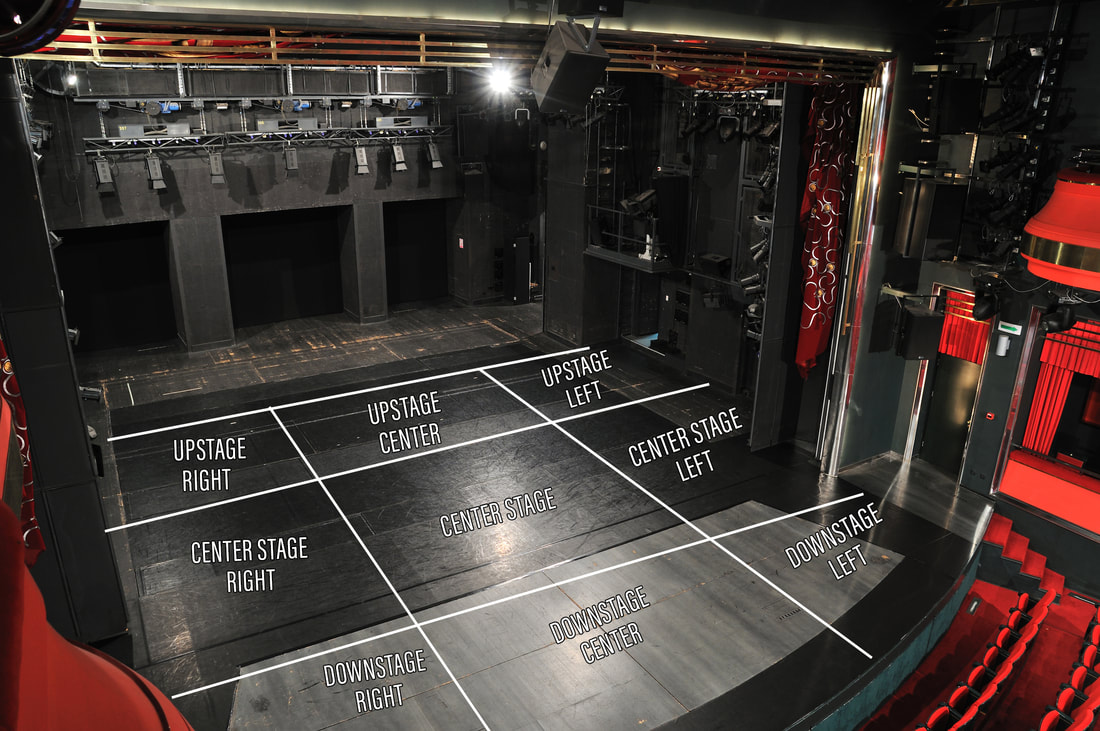Zquest One of the Path s Directions is Also the Normal Exit Direction Continue
Stage directions are instructions written into a script that dictate how an actor should move or what they should do in a scene.
In this guide, we'll dive deep on stage directions, including what they mean, where different parts of the stage are, and how to interpret them properly so you don't make a mistake and look inexperienced!
Related: Create Your Theater Resume (includes free Google Docs templates)

Stage Directions
Stage directions in a script are there to give actors and directors a general sense of what should be happening in each scene. They tell actors where to stand/sit, whether to enter/exit, and even if an actor should say something a certain way (normally these instructions come from the Director, but some writers like to include performance notes if they're necessary to tell the story).
Stage directions are usually very simplistic – only there to help readers understand the basics of what's going on. In fact,
many directors will completely change the stage directionsdepending on the set and how they want the performance to go.
In addition to informing actors of how to move or perform, stage directions also include information on lighting, scenery, and certain sound effects.
What is the Purpose of Stage Directions?
So what is stage direction in a story? Stage directions offer information on the following three things:
- Setting: This includes information about the time of day, location, and even descriptive wording to describe the location. This info is important to properly design the set and know where the scene is taking place.
- Example: Int. House - Day. We open on a small suburban house. In the middle of the room is a fancy couch with numerous throw blankets laying across it.
- Emotion: Parentheticals (words in parentheses) allow writers to give characters some emotion to their words. Typically, writers will only include parentheticals if they are critical to telling the story. Specific performance notes are almost always for the director to decide. Related: Natural Acting: The Ultimate Guide
- Example: John: (sarcastically) Well, I'm really happy to hear you're moving in with us, dad!
- Movement: To describe how actors move throughout the scene. In theater, there are specific words to describe where on stage the actor should go to (Center Stage, for instance), but in film and TV, movement notes are more generalized since there is no stage with a distinct front, middle, and back.
- Example: MARY exits as JOHN walks CS.
- In this case, CS means "Center Stage" (we'll go through the abbreviations shortly)
- Example: MARGARET sits to the left of JIMMY.
- Example: MARY exits as JOHN walks CS.
Let's now turn our focus to movement based stage directions. There are a few very important factors to keep in mind when understanding basic stage directions and where a script is asking you to go:
- Left vs. Right: In theater, stage directions are ALWAYS written from the perspective of the actor facing the audience. If it says Margaret sits to the left of Jimmy, it means Margaret to the audience's right of Jimmy. Stage Left and Stage Right again mean from the actor's perspective, facing the audience. In film however, it's not as clear, and the director will usually be the one to decide after seeing the location they're shooting at. You'll be more likely to encounter words like Camera Left and Camera Right, which means from the camera's perspective – exactly the opposite of Stage Left and Stage Right.
- Downstage vs. Upstage: In Shakespeare's time, stages use to be built on an incline so audiences could see more easily (before they had stadium seating). The front of the stage was lower physically than the back of the stage, so the term "downstage" meant front of the stage (closest to the audience) and "upstage" meant back of the stage. The meaning has not changed to this day. All theaters have three zones from back to front: Upstage (rear of the stage), Centerstage (middle), and Downstage (front of the stage).
- Three-Zone or Five-Zone Theaters: Smaller theaters have three zones, and larger ones have five zones. A Three-Zone theater will have three sections from left to right unsurprisingly called Left, Center, and Right, and a Five Zone theater will have five, which are calledLeft, Center-Left, Center, Center-Right, and Right. Again, remember that each zone is left or right from the actor's perspective while facing the audience.
- Prompt Side vs. Opposite Prompt Side: One final note before we move onto abbreviations: In British theater and in some theaters in the USA, there is something called "Prompt Side" and "Opposite Prompt Side." Most theaters have a prompt corner where an actor can go if they need prompt (line reading) because they forgot their next line. Typically this "prompt corner" will be on Stage Left although it can sometimes be opposite. Regardless, instead of using L and R for stage directions, they would use P and OP so it's less confusing about who's left or who's right they're talking about.
Stage Directions Examples & Abbreviations
Most stageplays use abbreviations for stage directions. Here is what all the abbreviations and stage directions vocabulary mean:
- C: Center
- D: Downstage
- DR: Downstage right
- DC:Downstage center
- DL:Downstage left
- R:Right
- L:Left
- U:Upstage
- UR:Upstage right
- UC:Upstage center
- UL:Upstage left
For extremely large theaters with 15 sections (instead of 9), here's an additional list of stage directions:
- DRC: Downstage right-center
- DLC: Downstage left-center
- RC: Right center
- LC: Left center
- URC: Upstage right-center
- ULC: Upstage left-center
And for theaters that don't use Right or Left, but instead use Prompt Side and Opposite Prompt Side, you would have the following abbreviations:
- C:Center
- D:Downstage
- DPS:Downstage prompt side
- DC:Downstage center
- DOPS:Downstage opposite prompt side
- PS:Prompt side
- OPS:Opposite prompt side
- U:Upstage
- UPS:Upstage prompt side
- UC:Upstage center
- UOPS:Upstage opposite prompt side
Hopefully your head isn't spinning! Again, here's the image from the beginning of this article that shows all the zones to make it easier to understand:

How to Follow Stage Directions
Here are a few general tips to help you do your best with stage directions:
- Read all available information. If you're performing a play and the script is available somewhere, go find it and read it in full. If, on the other hand, the complete script is unavailable, simply read everything you can to ensure you have as much information as possible, and then do your best to make a decision based on that. Here's my Ultimate Guide to Preparing for Auditions.
- Pay attention to stage directions because they can impact your performance. For instance, if a loud CRASH is heard in the distance in the middle of your long monologue, you probably need to react to it.
- Don't be afraid to ask questions. If you're going in for an audition and notice a certain stage direction that confuses you (or you have no idea how to mime it in the audition), simply ask the casting director what they'd like you to do. Don't feel afraid of them – they want you to do a good job!
- Follow stage directions unless told not to. The director or casting director will be able to give you specific instructions on something you're unsure about, but the general rule of thumb as mentioned earlier is that you should ALWAYS follow the script as written unless told otherwise. Stage directions are there for a reason!
3 Numbers All Actors Should Know
Understanding stage directions is important, but it's just one small part of growing your acting career.
If your goal is to act full-time, you should know these 3 numbers:
- 40-60 Submissions – This is how often full-time, working actors submit themselves (whether they have an agent or not) each month.
- 10-20 Auditions – This is how many times full-time working actors audition (or at least record and submit self-tapes) each month.
- 3-5 Bookings – This is how often full-time working actors book real, paid acting jobs each and every month.
If your numbers aren't there yet, that's OK! It's certainly not easy to audition and book that much.
But those areactual, real numbers from busy, working actors
who didn't just get lucky.
Those busy, working actors started at the beginning – for them, the biggest question swirling in their minds at the time was:
How do I get taken seriously by casting directors when I don't have good credits or footage? And how do I get credits/footage without being taken seriously by casting directors?
It's the classic actor's catch 22.
When we're struggling to get our careers off the ground, our minds can slip into "desperation mode" and start looking for quick-fix solutions. We'll ask ourselves questions like:
- "Should I take another acting class?"
- "Do I need better headshots or s hould I pay to shoot a reel?"
- "What's the fastest way to get an agent?"
But questions like those mean you're focused onTactics, instead ofStrategy.
Think about it this way: Would you bake a cake by randomly sliding a pile of flour, eggs, and chocolate into the oven? Of course not! How you combine the ingredients, the temperature you cook it at, and for how long are all just as important.
Similarly, the long-term, well thought-outstrategy you follow as you grow your acting career matters. A LOT.
That's why "strategic thinking" is one of the greatest gifts you can give yourself as an actor.
So today I'd like to give you a gift: 3 tools specifically designed to help you start thinking and operatingstrategically.
These tools have helped over 14,000 actors so far, many of whom have gone on to:
- Book Broadway roles
- Land network television and Netflix shows
- Sign with agents and managers
- And much more – faster than you'd expect (you can seesome success stories here).
My free Actor's Toolkit will help you BLAST through the actor's catch 22 so you start getting WAYmore auditions and bookings every month.
| The Actor's Toolkit:
| |
| | Martin Bentsen (author of this guide) is an actor marketing coach who uses strategic thinking to help actors book more work. He's helped over 14,000 actors with their careers andactor headshots since 2009 and his photography studio City Headshots is ranked #1 on Yelp. He's spoken at NYU, The New England Theater Conference, The Actor's Green Room, and other venues. to create new opportunities right away, or visit his website at www.martinbentsen.com. |
Some Additional Q&A
What are the 5 Stage Directions?
The 5 stage directions arecenter stage, stage right, stage left, upstage, and downstage.
What are the 9 Stage Directions?
The 9 stage directions arecenter stage, center stage left, center stage right, upstage, upstage left, upstage right, downstage, downstage left,and downstage right.
What is Stage Direction and Setting?
Stage direction and setting is essentially the basic information included in a screenplay to tell you where the scene is taking place and what movement is necessary for each actor during the scene.
Further Reading:
Source: https://www.cityheadshots.com/blog/stage-directions


0 Response to "Zquest One of the Path s Directions is Also the Normal Exit Direction Continue"
Post a Comment